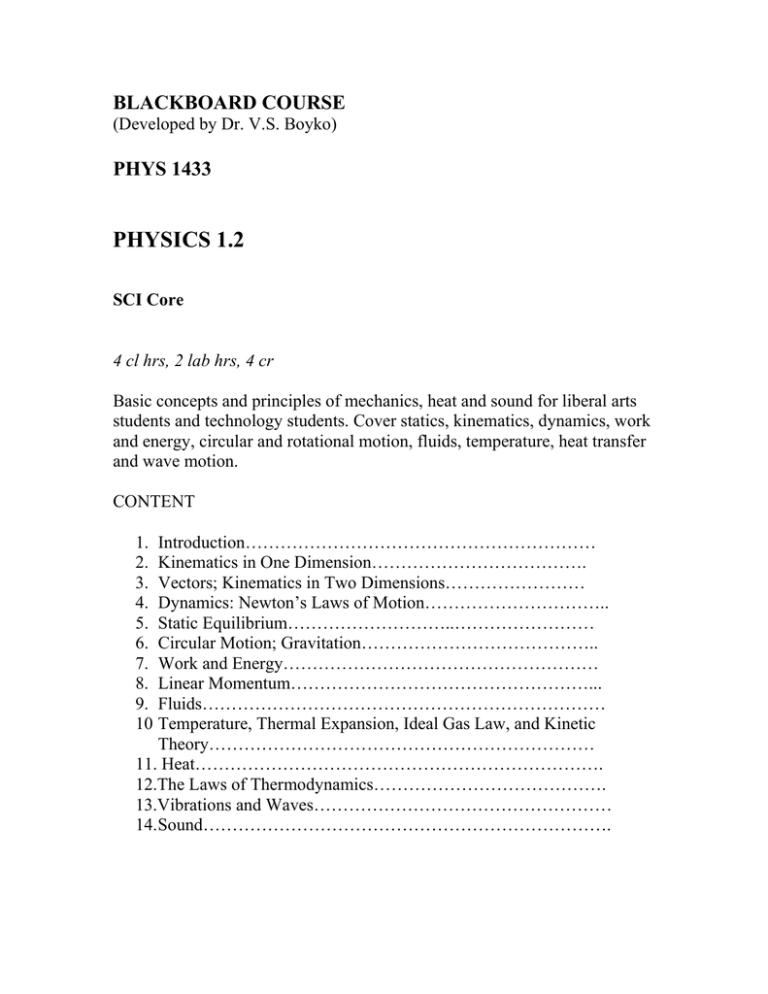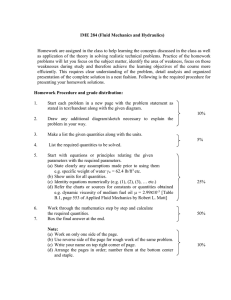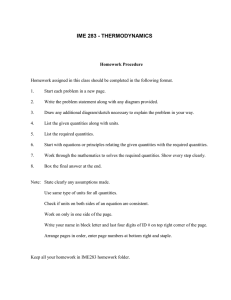
BLACKBOARD COURSE
(Developed by Dr. V.S. Boyko)
PHYS 1433
PHYSICS 1.2
SCI Core
4 cl hrs, 2 lab hrs, 4 cr
Basic concepts and principles of mechanics, heat and sound for liberal arts
students and technology students. Cover statics, kinematics, dynamics, work
and energy, circular and rotational motion, fluids, temperature, heat transfer
and wave motion.
CONTENT
1. Introduction……………………………………………………
2. Kinematics in One Dimension……………………………….
3. Vectors; Kinematics in Two Dimensions……………………
4. Dynamics: Newton’s Laws of Motion…………………………..
5. Static Equilibrium………………………..……………………
6. Circular Motion; Gravitation…………………………………..
7. Work and Energy………………………………………………
8. Linear Momentum……………………………………………...
9. Fluids……………………………………………………………
10 Temperature, Thermal Expansion, Ideal Gas Law, and Kinetic
Theory…………………………………………………………
11. Heat…………………………………………………………….
12.The Laws of Thermodynamics………………………………….
13.Vibrations and Waves……………………………………………
14. Sound…………………………………………………………….
RESOURCES:
1. H.D. Young, R.M. Geller, “Sears and Zemansky’s College Physics”,
8th Edition, Pearson / Addison –Wesley.
2. D.C. Giancoli, Physics: Principles with Applications, 6th Edition,
Pearson / Prentice Hall.
3.D.C. Giancoli, Physics for Scientists and Engineers, 3rd Edition,
Prentice Hall.
4. H.D. Young, R.A. Freedman, University Physics, 9th Edition, Addison
– Weley.
5. R.A. Serway, Physics for Scientists and Engineers, 4th Edition,
Sounders College Publishing.
6. D. Halliday, R. Resnick, J. Walker, Fundamentals of Physics, 6th
Edition, John Wiley and Sons.
7. R. Resnick, D. Halliday, K.S. Krane, Physics, 4th Edition, John Wiley
and Sons.
8. J.S. Walker, Physics, 2nd Edition, Pearson / Prentice Hall.
1. INTRODUCTION.
Key Words: Physics, Scientific method, Physical quantity, Physical Law,
Physical Principle, Measurement, Measurement, Estimated
Uncertainty, Percent Uncertainty, Significant Figures, Scientific
Notation, Physical Units, Base Units, Derived Units, System of Units, SI
System of Units (Metric System), British Engineering System of Units,
Standard of Units, Unit Conversion, Dimensional Analysis.
Physics is the most basic of the sciences. It deals with the behavior and
structure of matter. It is the most advanced science and base of all sciences.
Physics formed technology basis of our civilization. Physics describe all
levels of Nature from elementary particles to the Universe as a whole. Why
Physics is so dramatically successful? The answer is the scientific method
developed in physics and then used by all other sciences. This method
consists of three parts: observations of natural events, which include the
design and carrying out of experiments; the creation of theories to explain
the observations; testing of theories to see if their predictions are confirmed
by the experiments. Despite the mathematical beauty of some of its most
complex abstract theories, including of those of elementary particles and
general relativity, physics is above all an experimental science. Any
beautiful and flawless from the mathematical point of view theory could be
accepted if it is supported by experiment. General statements about how
nature behaves are called the physical law. The building blocks of physics
are the physical quantities that used by physicists to express the laws of
physics. Among them are length, time, speed, acceleration, mass, force and
so on. Laws of physics usually have the form of a relationship or equation
between the physical quantities.
It was written above that physics is experimental study and results from
measurements. But, at the same time, no measurement is absolutely precise.
There is an uncertainty associated with every measurement. This
uncertainty stemmed from the limited accuracy of our instruments, from
uncontrollable changing of the conditions of measurements and so on. When
giving the result of a measurement, it is important to show estimated
uncertainty. If the estimated uncertainty for a physical quantity A is a then
the result of measurement can be written as A ± a. This means that the actual
value of A is most likely lies between (A – a) and (A + a). The percent
uncertainty is (a/A) × 100%. Other form of stating uncertainty often is used
by keeping in a quantity the correct number of significant figures.
Significant figures are the number of reliably known digits in a numerical
value of physical quantity. The significant figures of the experimentally
measured value include all numbers that can be read directly from the
instrument scale plus one estimated number. So the last digit is estimated.
When doing calculations with measured physical quantities, you need to
follow the rule that final result of a multiplication or division should
have only as many digits as the number with the least number of
significant figures used in the calculation. The same we can say for the
addition or subtraction of the numerical values of physical quantities: the
final result is no more accurate that the least accurate number used. Using a
calculator, remember that not all produced digits are accurate.
However, to obtain the most accurate result, you can keep all calculator
digits in intermediate results and round off final result to the proper number
of significant figures. Remember that it is treated as a mistake when
students write final result of the problem with all digits displayed on the
student’s calculator. Give final result only in terms of significant figures.
Remember, this is physics. Precision of the result is determined by the
precision of the experimental data. We could not increase precision of result
just by more precise calculations.
It is not clear sometimes how many significant figures some number has. For
example, if there are zeros at the end of the number, we need additional
information to know whether these zeros are significant digits or just zero
holders. The ambiguity can be avoided if we write numbers in “scientific
notation” or “powers of ten”. To write a number in scientific notation,
express it as a number containing exactly one nonzero digit to the left of the
decimal point (total number of digits should be exactly equal to the number
of significant figures of this physical quantity) multiplied by the appropriate
power of ten. This approach is extremely useful in physics because physics
describe nature at all levels from elementary particles to universe as a whole.
Studying physics, we will encounter in very small or very large numbers.
For example, the mass of electron in regular notation can be written as me =
0.00000.... (30 zeros in all)…000911 kg. Mass of the Sun can be written as
MΘ = 19900…(28 zeros in all)…00… kg. In scientific notations these
physical quantities will be written as follows: me = 9.11×10^(-31); MΘ =
1.99×10^(+30) kg.
The founder of scientific method Galileo Galilei stated, “the book of Nature
is written in math”. Therefore Mathematics is extremely important in
Physics. Our course is algebra-based course. We will need some basic
concepts of elementary geometry and trigonometry as well. All mathematics
that we need is described in the Mathematical Review (see the section
Appendices in the textbook).
Measurement
The experiment is first of all the measurement of physical quantities.
Measurement means comparison of measured quantities with some
standards of these quantities. It is therefore critical that those who make
precise measurements be able to agree on standards in which to express the
results of those measurements, so that they can be communicated from one
laboratory to another and verified. We begin our study of physics by
introducing some of the basic units of physical quantities and the standards
that are accepted for their measurement.
If you will analyze the textbook you will see that in each chapter new
physical quantities are introduced and accordingly new units should appear.
How can we organize this multitude of units? But it is very interesting that
there are few base units through which all other units (derived units) can be
expressed. It looks like a mystery. We will try to explain this mystery on the
example of the first branch of physics that we will study - Mechanics.
Mechanics study the motion of material objects in space and time. The base
quantities of mechanics are length (the characteristic of space), mass (the
characteristic of matter), and time. All other units in mechanics result from
multiplication and /or division of fundamental units. Derived unit can be
determined from the formula that defined corresponding physical quantity.
For example, unit of speed can be determined from the corresponding
formula
EXAMPLE 1.1. Speed Definition
Speed = (distance covered)/(time needed)
(1.1)
We might operate with units by the same way as with numbers. Therefore to
find unit of speed we should divide a unit of length by a unit of time.
System of Units
Depending of what units were chosen as the base units, there are different
systems of units. We will use international system of units, which is
abbreviated SI. In the SI system, the base units: unit of length is 1 meter
= 1 m; unit of time is 1 second = 1 s; unit of mass is 1 kilogram = 1 kg.
Because meter is a base unit of this system, the SI system sometimes is
called a metric system. In the United States, British Engineering System is
in use for every day life and partially in technology. The base units in this
system are as follows: the unit of length is 1 foot = 1 ft; the unit of time is 1
second = 1 s; the unit of force 1 pound = 1 lb.
Usually we will use the SI (metric) system because it has some advantages.
First of all, this system of units is used in science through the all world.
Second, in the SI system, the larger and smaller units are defined in
multiples of 10 from the standard unit, and this makes calculations easy.
Adding a prefix to the name of the fundamental unit derives the names of the
additional units. For example, the prefix “kilo”, abbreviated k, always means
a unit larger by a factor of 1000:
1 kilometer = 1 km= 10³ meters = 10³ m
1 kilogram = 1 kg = 10³ grams =1 10³ g
Here are several examples of the use of multiples of 10 and their prefixes
with the units of length, mass, and time.
LENGTH:
1 nanometer = 1 nm = 10^(-9) m (a few times the size of the largest atom)
1 micrometer = 1 μm = 10^(-6) m (size of some bacteria and living cells)
1 millimeter = 1 mm = 10^(-3) m (diameter of the point of a ballpoint pen)
1 centimeter = 1 cm = 10^(-2) m (diameter of your little finger)
Compare these relationships with relationships between units of the length in
the British Engineering System: 1 mi = 5280 ft, 1 ft = 12 in.
TIME:
1 ns = 10^(-9) s (time for light to travel 0.3 m)
1 μs = 10^(-6) s (time for a computer to perform few addition operations)
1 ms = 10^(-3) s (time for sound to travel 0.33 m in the air)
MASS:
1 μg = 10^(-9) kg (mass of a very small dust particles)
1 mg = 10^(-3) g = 10^(-6) kg (mass of a grain of salt)
1 g = 10^(-3) kg (mass of a paper clip)
The prefixes can be applied to any other metric units. For example,
1 megawatt = 1 MW = 10^6 watts = 10^6 W.
STANDARDS OF UNITS
For any unit we use, we need to define a standard, which defines exactly this
unit value. It is important that standards be reproducible and accessible.
With the progress of the methods of measurement, more precise standards
are introduced. The good example is the history of the unit of length in SI
system -- meter that evolved over the years. When the metric system was
established in 1791 by the French Academy of Sciences, the meter was
defined as one ten-millionth of the distance from the North Pole to the
equator. A platinum rod to represent this length was made. The last
definition of the meter was established in 1983: “The meter is the length of
path traveled by light in vacuum during a time interval 1/(299,792,458) of a
second. This provides a much more precise standards of length than before.
But you can see that it includes the new standard of time. For many years the
second was defined as 1/(86,400) of a mean solar day. The present standard,
adopted in 1967, is much more precise. It is based on an atomic clock, which
uses the energy difference between two lowest energy states of the cesium
atom. When bombarded by microwaves of the precisely proper frequency,
cesium atoms undergo a transition from one of these states to the other. One
second is defined as the time required for 9,192,631,770 cycles of this
radiation.
Unit Conversion
Remember, that physical quantity must always include number and
unit. When you will solve problems, always write for any physical quantity
the numerical value and unit. Do not forget to write unit. Physical quantity
written without unit is treated as a mistake disregarding whether its
numerical value is wrong or write. Solving problems, start with analysis of
data. You can get write answer for a problem only if you use consistent
system of units. It means that all physical quantities in the problem must be
expressed in the units of the same system of units. If it is not so you should
make conversion of units. How the conversion of units can be made?
Units are multiplied and divided just like ordinary algebraic symbols.
This gives us an easy way to convert a quantity from one system of units to
another. The key idea is that we can express the same physical quantity in
two different units and form equality. For example, When we say that 1 m =
3.28 ft, we do not mean that number 1 is equal to the number 3.28; we mean
that 1m represents the same length as 3.28 ft. For this reason, the ratio
(1m)/(3.28 ft) equals 1, as does its reciprocal (3.28 ft)/(1m). Since
multiplying or dividing by 1 does not affect the value of any quantity, we
can multiply any physical quantity by either of these factors without
changing this quantity’s physical meaning. These ratios (1m)/(3.28 ft) =1 or
(3.28 ft)/(1m) = 1 are called conversion factors. To illustrate the technique
of converting from a base unit of one system of units to a base unit of
another, we will solve the following example.
EXAMPLE 1.2: The Empire State Building versus the Eiffel Tower.
(a) The Empire State Building in New York City is 1250 ft high without its
television tower. Express the height of the Empire State Building in meters.
(b) The Eiffel Tower in Paris is approximately 300 m tall. Express the height
of the Eiffel Tower in feet.
You should take the relationship between units in question from textbook.
(A Table containing many relationships between units can be found inside
the front cover of this book). In our case, it is 1m = 3.28 ft. Then prepare
from this relationship two conversion factors :(1m)/(3.28 ft) =1 and (3.28
ft)/(1m) = 1. Choose the right conversion factor, this is one in which
desirable unit is in the numerator. Multiply the given height by the
conversion factor. Because units may be treated as any algebraic quantity
they can be cancelled. If you do unit conversions correctly, unwanted units
(feet in the question (a) of our example, and meters in the question (b) of this
example) would be cancelled out.
(a) (1250 ft) × (1m)/(3.28 ft) = 381 m.
(b) (300 m) ×(3.28 ft)/(1 m) = 984 ft.
If instead you had multiplied by wrong conversion factor you would get
senseless answer.
(1250 ft) (3.28 ft)/(1 m) = 4100 (ft)²/(1 m)
When you need to convert derived unit from one system to another, prepare
so many conversion factors how many units in derived unit you should
convert. Multiply given quantity by all these conversion factors. Undesirable
units should be cancelled out. To illustrate the technique of converting from
a derived unit of one system of units to a derived unit of another, we will
solve the following example.
EXAMPLE. 1. 3. Speed limit. According to “Driver’s Manual”, you must
obey the posted speed limit, or if no limit is posted, drive no faster than 55
mi/h (55 miles per hour). Express this speed limit (a) in km/h and (b) in m/s.
(a) In this case, we need to convert only one base unit. Therefore we
should use only one conversion factor to transfer mi to km. From
textbook 1mi = 1.609 km. From this relationships we can get two
conversion factors: (1 mi)/(1.609 km) = 1 and (1.609) and (1.609
km)/(1 mi) =1. To get rid of undesirable unit we should use second
conversion factor
55 (mi)/(h) × (1.609 km)/(mi) = 88. 5 (km)/(h)
Undesirable unit (in this case mi) disappear and we get answer in
(km)/(h).
(b) Now we need to convert two units, so we should prepare conversion
factors for each of them. The right factors are (1000 m)/(I km) = 1 and
(3600 s)/(1 h) = 1. The answer will be
88.5 (km/h) ×(1000m)/(1 km)×(1 h)/(3600 s) = 24.6 m/s
This is important statement, and it will be repeated again. When a
problem requires calculations using numbers with units, always write the
numbers with the correct units and carry the units through the calculation.
This provides a very useful check for calculations. If at some stage in a
calculation you find, that an equation or an expression has inconsistent
units, you know you have made an error somewhere. This technique is
called Dimensional Analysis. The dimensions of a quantity are type of
units or base quantities that make it up. For example, the dimensions of a
volume is always length cubes, abbreviated {L³], Dimension of speed are
always a length [L] divided by time [T], so [v] = [L]/[T]. In any equation,
expressing physical relationships, after the mathematical procedures of
addition, subtraction, multiplication, division, and cancellation have been
performed, the units on one side of equation must equal the units on the
other side, the same statement can be said for each term in equation.
These are some basic concepts of the language of physics, now we will
begin to study real physics. We will start with the branch of physics called
Mechanics. Mechanics describe a motion.






![(∆f ) = [δf/δx] (∆x) + [δf/δy] (∆y) + [δf/δz] ∆Α/A = 0.08/2.30 + 0.05/0.60](http://s2.studylib.net/store/data/018343746_1-dc88b467ace9f84b1ce5d72ffb7a0e63-300x300.png)
